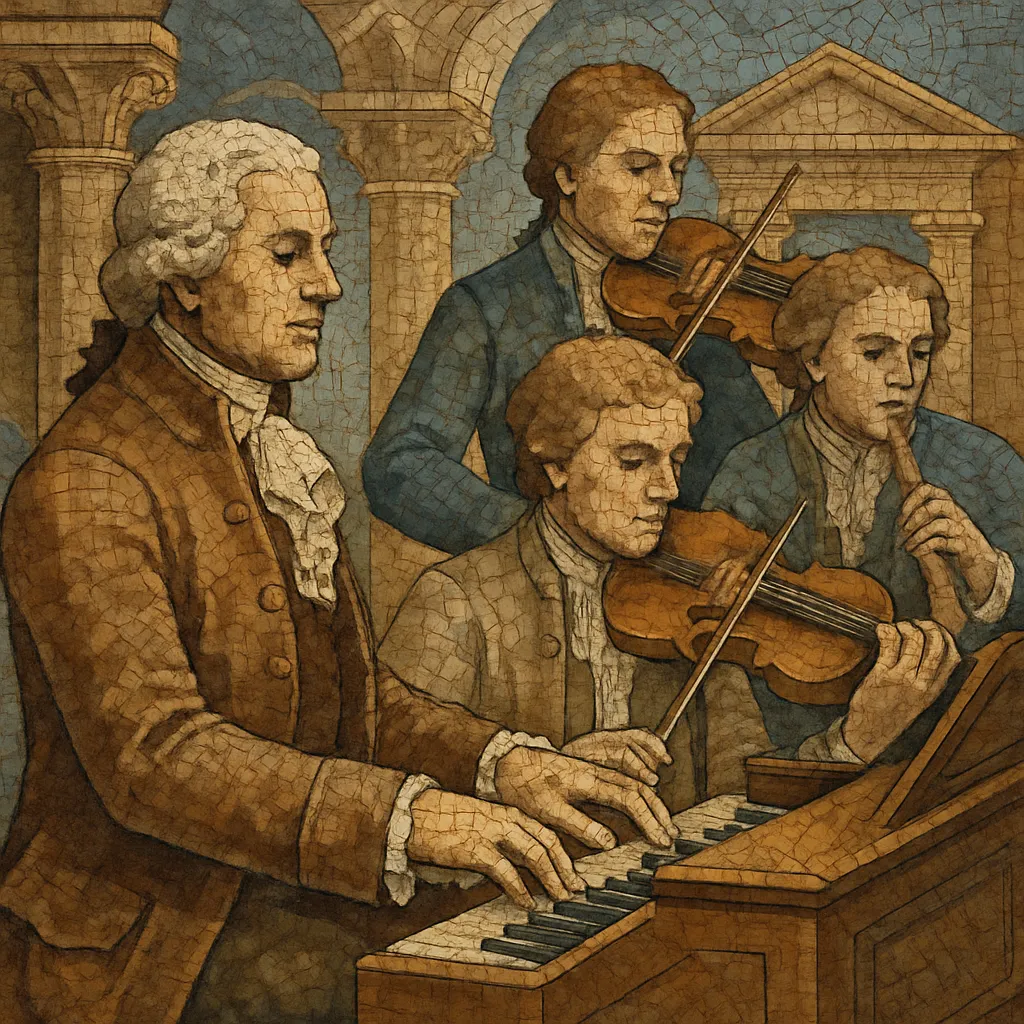The Classical period in Western art music (c. 1750–1820) is defined by clarity of form, balance of phrase, and transparent textures. Composers favored singable melodies, symmetrical four- and eight-bar phrases, and functional harmony that modulates to closely related keys.
Hallmark forms such as the symphony, string quartet, sonata, and classical concerto were standardized, often using sonata form, theme-and-variations, minuet and trio, and rondo designs. Orchestras expanded beyond strings to include standardized pairs of woodwinds and horns, with trumpets and timpani for ceremonial weight, while the fortepiano gradually replaced the harpsichord.
The style pivoted away from the dense counterpoint of the late Baroque toward a more galant, conversational musical rhetoric. It culminated in the Viennese masters—Haydn, Mozart, and the early Beethoven—whose works crystallized the era’s ideals and prepared the way for Romanticism.
The Classical period emerged in the mid-18th century as a reaction to the complexity of late Baroque counterpoint, elevating clarity, proportion, and expressive restraint. Centered largely around Vienna, it codified forms and ensembles that remain foundational in Western music education and concert life.
Seeds of the style appeared in the galant and empfindsamer currents, emphasizing naturalness, balanced phrases, and clear tonal plans. Early symphonies and sonatas simplified texture to melody with accompaniment (often Alberti bass), while opera reformers sought dramatic plausibility and musical continuity.
Joseph Haydn standardized the multi-movement symphony and string quartet, developing motivic economy and thematic development. Wolfgang Amadeus Mozart expanded dramatic and harmonic nuance across opera, symphony, concerto, and chamber music. Orchestras settled into a flexible but recognizable “classical” layout of strings, pairs of winds, horns, and frequently trumpets and timpani.
Ludwig van Beethoven absorbed Classical syntax yet pushed structural scale, rhythmic drive, and tonal exploration, forging a bridge to the Romantic era. Public concert life grew, patronage diversified, and the fortepiano’s dynamic capability reshaped keyboard writing and performance.
The period witnessed the rise of public subscription concerts, music publishing, and a pan-European exchange of style. Its formal templates—sonata form, the four-movement symphony, the concerto’s dialogue—became pedagogical norms and influenced 19th- and 20th-century neoclassical revivals.
Use a Classical orchestra: strings (first and second violins, violas, cellos, double basses), pairs of oboes and bassoons (later clarinets), pairs of horns, and occasionally trumpets and timpani. For chamber music, prioritize string quartet and piano-based ensembles; for solo works, write for fortepiano rather than harpsichord.
Design movements with clear forms: sonata form (exposition–development–recapitulation), theme and variations, minuet and trio (or scherzo late in the era), and rondo/sonata-rondo finales. Aim for balanced, periodic phrasing (e.g., 4+4 bars) and clear tonal plans (I → V or I → III in major; i → III in minor), with a convincing return to the tonic.
Write diatonic, singable melodies with tasteful ornamentation (trills, appoggiaturas). Harmonies should be functional with cadential clarity, using modulation to closely related keys. Employ Alberti bass, broken-chord textures, and simple accompaniment figures that support rather than obscure the melody.
Favor homophony—melody with accompaniment—while using counterpoint for contrast and developmental tension. Motivic development (fragmentation, sequence, inversion) is central, especially in developments of sonata form.
Use clear metric organization and buoyant rhythmic profiles. Employ graduated dynamics (crescendo/decrescendo) rather than terraced changes, and articulate with lightness and clarity; avoid overly dense textures. Cadences should be well-prepared and rhetorically satisfying.
Keep vibrato restrained (especially in strings), articulate ornaments crisply, and prioritize clarity of inner voices. On keyboard, exploit dynamic shading and articulation contrasts available on the fortepiano.
Avoid Baroque-like continuous counterpoint throughout; ensure phrases breathe and cadences are audible. Keep textures transparent, modulations logical, and formal boundaries perceptible to the listener.


